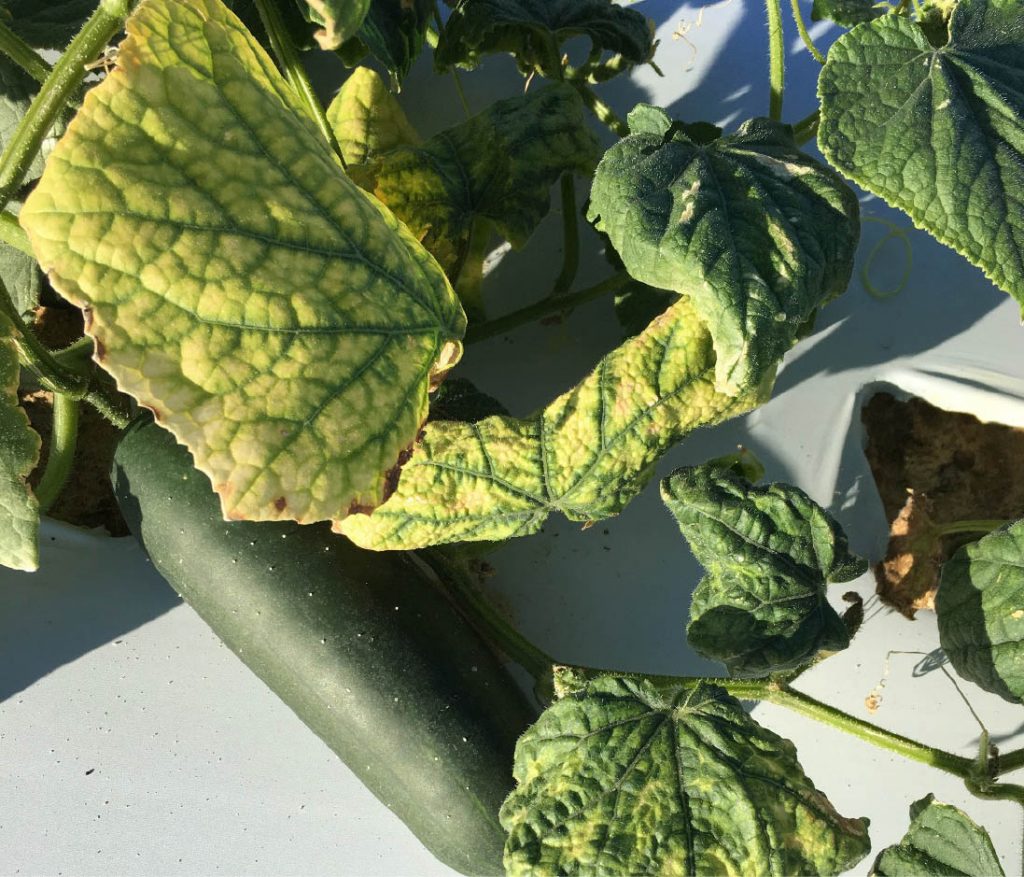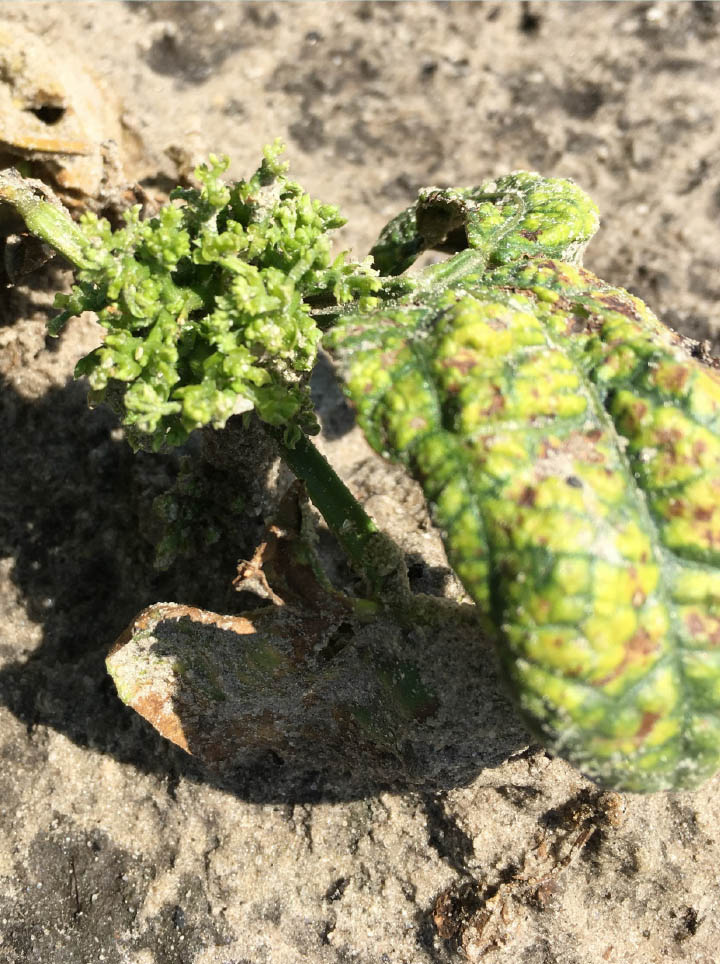
By Bhabesh Dutta and Rajagopalbabu Srinivasan
The silverleaf whitefly (Bemisia tabaci), also known as sweetpotato whitefly, is a pest of several horticultural and agronomic crops in southern Georgia. While direct feeding can injure plants and lead to problems such as silvering of leaves, deposition of honeydew and formation of sooty mold, whiteflies also can transmit numerous devastating plant viruses. Transmission of such viruses presents the greatest threat to economic production of many vegetable crops, particularly tomatoes, snap beans and most cucurbits.
VIRUS INCIDENCE AND TYPES
Virus incidences vary greatly from year to year, but pressure is typically greatest in crops grown during the fall and is severe in the areas around Tift and Colquitt counties. In 2016 and 2017, whiteflies were widely distributed throughout southern Georgia, and virus diseases decimated tomato, snap bean and cucurbit crops throughout the area. In contrast, in 2018–2020, the whitefly pressure was not as severe and caused economic losses less than 10% across vegetable crops grown in the fall.

The major viruses transmitted by whiteflies in southern Georgia include the cucurbit leaf crumple virus (CuLCrV), cucurbit yellow stunting disorder virus (CYSDV), sida golden mosaic virus (SiGMV) and tomato yellow leaf curl virus (TYLCV). Squash vein yellowing virus, which is of major concern in Florida, also poses an additional threat to cucurbits in Georgia.
Whiteflies can also transmit numerous other viruses to vegetable crops, but they have not presented significant problems in Georgia to date. All these viruses are phloem-limited and are not known to be seed-transmitted. Mechanical transmission has not been reported either. Whitefly-mediated transmission seems to be the exclusive mode of spread.
Production season and corresponding planting date has a tremendous impact on potential virus incidence in Georgia. In typical years, whiteflies and whitefly-transmitted viruses are not threats during the spring production season and may not require any specific management practices. However, whitefly and virus pressure can easily overwhelm most management strategies in the fall.
GROWER RECOMMENDATIONS
When available, management of plant viruses is best achieved with resistant varieties of the host plant. For instance, TYLCV can be somewhat well-managed using resistant tomato varieties. Currently, these varieties possess semi-dominant resistance genes. Resistant cultivars are not immune to the virus infection and can show mild symptoms. However, these cultivars yield well under high-pressure virus scenarios. Unfortunately, host resistance is not available against any other whitefly-transmitted virus mentioned in this article.

It is essential to ensure transplants are free of both virus and vectors before planting. Transplants should be produced in virus-free locations when possible. Avoid planting adjacent to older crops that are already infested with whiteflies and/or harboring viruses.
Other management approaches may suppress or delay virus incidence when the virus and/or vector pressure is low, but there is minimal to no impact when whitefly density and virus incidence are high. Alternative management tactics, such as use of reflective mulches and insecticidal control of the vector, have shown to work best when implemented in an integrated fashion.
Management of viruses through insecticidal control of the whitefly vector will work best when vector densities are low and secondary infection is the primary method of virus spread. Insecticides currently used against whitefly are efficacious on immature stages but provide little or no impact on adults.
Sanitation is important, particularly in preventing carryover and increases in whitefly populations and virus incidence from one crop to subsequent crops. Growers should remove and destroy old crops/volunteers (e.g., plowing/physical removal) as soon as a crop is finished. Removal of weeds in and around fields can be beneficial because weeds may be reservoirs for the virus and support whitefly populations.
VIRUS MANAGEMENT PROGRESS
We are investigators in several U.S. Department of Agriculture-funded projects on the management of whiteflies and whitefly-transmitted viruses in vegetables. Our programs have extensively collaborated with other University of Georgia (UGA) scientists, including horticulturists (Tim Coolong and Andre da Silva), an entomologist (Stormy Sparks), a vegetable breeder (Cecilia McGregor) and with Somashekhar Punnuri, a plant biologist from Fort Valley State University. Listed below are some highlights of the progress made in the last three years and ongoing research.

- Twenty snap bean cultivars with high to moderate levels of resistance (disease severity ranging from 5% to 50%) to CuLCrV and/or SiGMV were identified in a multi-year field screen. Greenhouse studies corroborated findings from the field screen.
- Twenty highly resistant snap bean plant-introduction lines were identified. In collaboration with plant breeders and molecular biologists from UGA and Fort Valley State University, the lines will be used in resistance breeding.
- Evaluation of host resistance for cucurbits is ongoing.
- Extensive efforts are being invested to gain basic knowledge on vector-virus interactions and virus transmission by whiteflies.
- Numerous cultural and chemical management options are being evaluated in experimental plots at the UGA Tifton Campus and directly in growers’ fields. Several promising tactics have been identified. For example, collaborative work showed that the use of row covers from transplanting to flowering can effectively protect squash from whitefly infestation and viruses (CuLCrV and CYSDV).
Our goal is to identify both short- and long-term sustainable solutions to tackle whiteflies and devastating viruses affecting important vegetable crops in Georgia. Our collaborative team is working tirelessly toward developing crop-specific management packages for growers.









